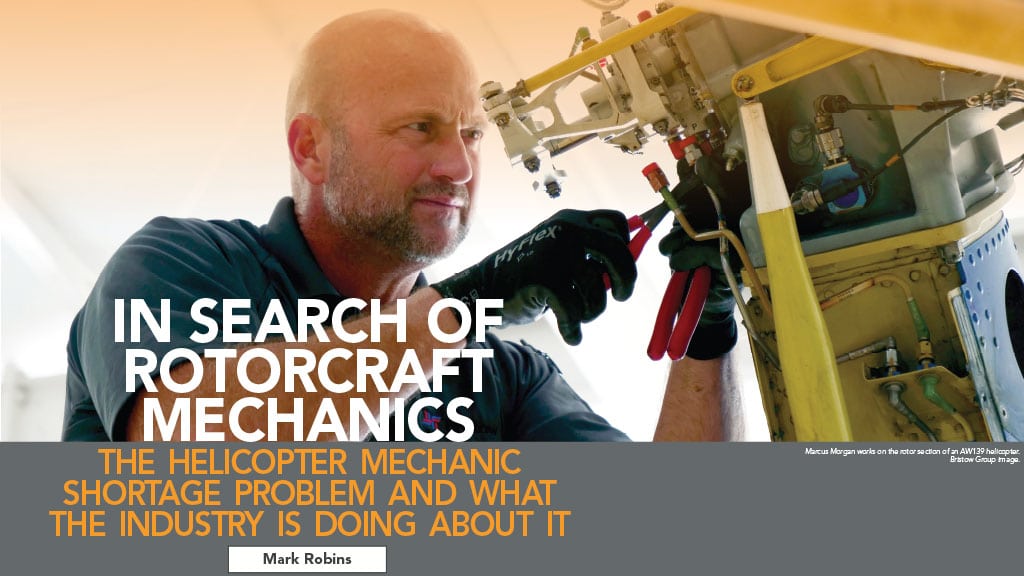Around the world, the rotorcraft industry — and to a larger extent the entire aviation industry — is struggling to fill vacant positions for maintenance technicians. The negative impact of this manpower shortage is especially severe at a time when the global rotorcraft fleet is expanding and modernizing. In 2020, the FAA issued 30% fewer new mechanic certificates than it did in 2019, a drop-off that the Aviation Technician Education Council (ATEC) described as “devastating” in its 2021 Pipeline Report. Without engine repair technicians, many fear there could be fewer rotorcraft in operation.
According to a 2017 Oliver Wyman report, “When Growth Outpaces Capacity,” executives from the MRO industry said they are indeed worried about an anticipated shortfall in the number of adequately trained aviation mechanics. A majority of survey respondents (78%) reported that it is getting harder to hire mechanics and the tightening labor market is pushing them to rely on overtime and other stop-gap efforts to keep up with market demand.
“One of the biggest impacts of the labor shortage is increased turn-around-times (TAT) for heavy maintenance checks and the limited availability of maintenance slots — the two are highly correlated,” said Jonathan Berger, managing director of Alton Aviation Consultancy. “Maintenance shops have limited capacity because the shortage of mechanics means aircraft overhauls take longer, which reduces the number of slots available. This labor shortage is not unique to the helicopter industry. Worldwide there is a shortage of mechanics in virtually every industry — e.g. automotive, rail, energy, IT, agriculture, etc. — and aviation is not immune: fixed wing and helicopters. Everyone is coping as best they can.”
Crystal Maguire, executive director of the Aviation Technician Education Council (ATEC), agreed that the rotorcraft industry is not going to have the maintenance personnel it needs. “Look at the entire workforce population and every sector has a problem. Its impact is there, and [the rotorcraft industry] is not going to have the workforce to support growth. But it’s not going to make the [rotorcraft] industry go away. [The industry] is going to figure out other ways if it doesn’t have the personnel to do it.”
Retirement, COVID and Vacancies
One of the most often cited reasons for this mechanic manpower shortage is retirement as more baby boomers reach their mid-60s and early retirement. This loss of experience compounds the overall skills shortage dilemma. According to the Oliver Wyman 2017 MRO survey, over the next decade, the record number of maintenance technicians eligible to retire will outpace the total of new mechanics entering the market. The median age of aviation mechanics is 51, nine years older than the median age of the broader U.S. workforce as calculated by the U.S. Bureau of Labor Statistics.
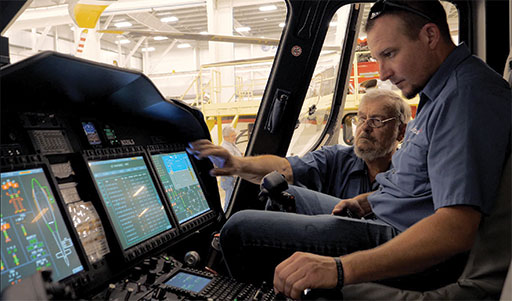
Maguire said she has witnessed, industry-wide, “an exodus of folks who were nearing retirement. We are still trying to get a better sense of that statistically. We have fast-forwarded our manpower shortage projections.” COVID-19 has exacerbated this problem; because of COVID, many senior rotorcraft mechanics were offered early-out buyout packages to retire early. “We knew we were going to have a problem if we didn’t already; that’s the biggest implication of COVID,” Maguire said.
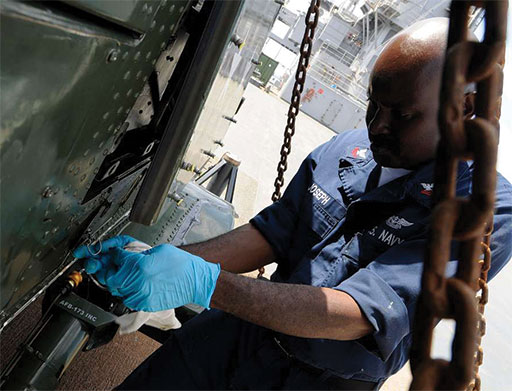
“Clearly the pandemic directly contributed to what many are calling the ‘great resignation,’” Berger explained. “I prefer the term the ‘great reflection.’ The global pandemic and associated lockdowns provided the opportunity for thoughtful introspection and to reprioritize what’s really important to them. The fact is that aviation is a very cyclical industry; for helicopters, oil and gas has experienced periods of tremendous boom and busts of the past several decades, and emergency air medical, and search and rescue (SAR) are quite stressful fields of work.”
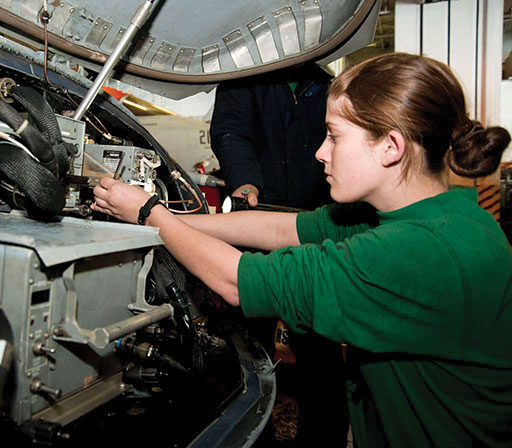
“In an odd way the pandemic may have helped the industry, because it allowed operators to retool, restructure, economize and strategize for the future,” said Zac Noble, director of maintenance and technology at Helicopter Association International. “Most helicopter operators were forced to slow their flight pace or stop them altogether. It isn’t good for operators or industry when that happens, but it allowed for the reorganization of assets internally to operations, but also allowed academic institutions to push needed pilots and mechanics into the stream. We are still facing shortages of mechanics. Flight operations are beginning to ramp back up in most cases for those who were not forced to close their doors for good. But because flight volume hasn’t returned to pre-COVID levels, maintenance operations are able to keep up with the pace, although it might require additional workdays or time in some cases.”
Not all companies were adversely affected by the pandemic and the mechanic shortages it produced. “We never shut down or reduced our operations during COVID-19, and in some ways picked up more work as a result of increased search-and-rescue medevac missions, mostly to transport COVID patients,” said Benjamin Hulshoff, director of maintenance at Bristow Group. “The biggest impact was with some staff workers who could work remotely, but for our aircraft maintenance technicians, that was not an option. We had more impacts to our operations from the hurricanes that hit the coast of Louisiana than we did from COVID-19.”
Filling Manpower Shortages
For most operators, filling rotorcraft engine mechanic vacancies has become more competitive, but they have still found ways to do it. “It does take a little more active recruiting to fill positions in today’s more challenging environment, but to date, we have not had any issues in the United States in obtaining good quality candidates,” Hulshoff said. “The helicopter industry is a very niche industry. Bristow has a strong reputation and offers very competitive pay and benefits. In the United States, when we merged with Era Group Inc. in June 2020, we also had a surplus of positions from combining the two companies, so we have not faced as many of the issues as other helicopter companies have faced.”
Maguire said ATEC has been working a lot on building awareness of rotorcraft mechanic perks and trying to attract more professionals to it across all sectors. “We are trying to approach this at a national level — getting stakeholders and coalitions together to talk about what we can do as a whole. What are the talking points? How can we all pull together as one to increase the pipeline, which would raise all boats. If more people were aware of the opportunities, we wouldn’t have this shortage problem. That’s what we are working on. You see planes flying around more than you see helicopters flying around, so it’s awareness. It behooves us to illustrate the broad range of opportunities available. There’s a lot of things to do with an Aircraft Maintenance Technician (AMT) license.”
Hulshoff said the rotorcraft industry needs to reach out to more women and minorities, who he believes are underrepresented in the field. Also, “I think a strong pipeline of candidates can come from the military services, and there are many experienced candidates serving in the military. The military branches are now helping their aircraft maintenance technicians obtain FAA certifications, which makes them more employable in the civilian sector. I also think we can help early career AMTs get their FAA certifications quicker and to offer more support for those who want to come into the field, whether they work in general aviation or a related field with similar skill sets. Making the process to obtain certification easier helps offer advancement routes for your aircraft maintenance technicians so they can have a long career with your company. We have a lot of workers who have been with our company 15 years or longer, which is unprecedented in other fields.”
Next Generation Rotorcraft Mechanics
To replace retiring rotorcraft mechanics and technicians, the rotorcraft industry is looking to attract, recruit and train a new generation of younger workers. And, as college tuition continues to rise, a career as rotorcraft technician could be viewed favorably by millennials because it doesn’t require a four-year college degree.
To fill vacancies, companies are getting creative, offering generous sign-on bonuses and other incentives in addition to competitive wages. Some students have even arranged for companies to pay their tuition instead of taking out student loans. To recruit tomorrow’s tech-savvy rotorcraft diagnosticians at a recent career fair in Ohio hosted by the Pittsburgh Institute of Aeronautics, companies were conducting on-site interviews and offering jobs to students on the spot.
Bristow has stepped up its recruiting efforts, including position marketing and participating in specific job fairs. “We also established maintenance scholarships at a local trade school in Louisiana to create a pipeline of AMTs,” Hulshoff said. “For our current workforce, our focus has been on the quality of life and to ensure we do our best to retain our AMTs.”
To help attract and train the next generation of rotorcraft mechanics, ATEC is working on a high school curriculum, planned for fall 2022, that includes rotorcraft maintenance to build awareness for young job seekers. “We are really trying desperately hard to get these programs in high school settings that would communicate these [rotorcraft mechanic career] pathways,” Maguire said. “They could do a lot of the training for free. Those are the programs that we encourage. It’s not going to come around without the industry taking a lead in it. [Build awareness] locally in high schools, that’s a great way to do it, and with mentors to get these programs in there. Building our own local pathway programs — that’s what we’ve seen is making the biggest impact for companies — getting involved at that local level.”
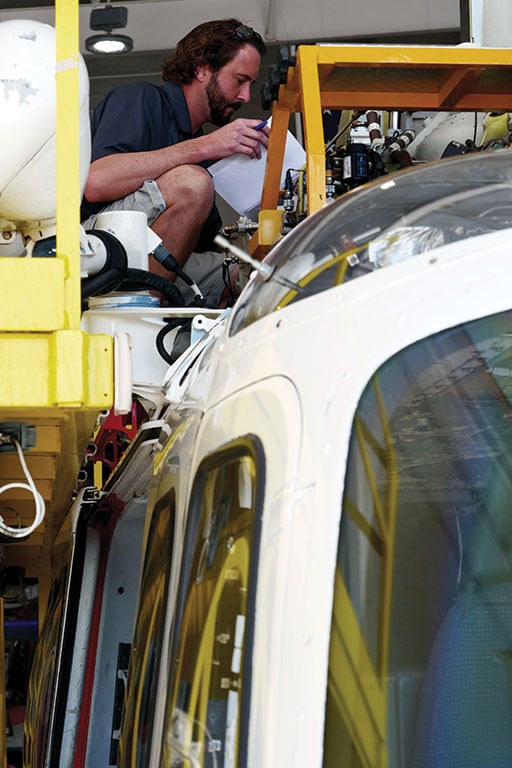
Helicopter Association International is a strong advocate for education accessibility. HAI and many other organizations offer scholarships to qualified applicants. “Additionally, the COVID pandemic created a pathway for remote learning from Part 147 certificated schools that can meet the published requirements,” Noble said. “Educational opportunities are available. I would encourage anyone interested in a career in aircraft maintenance, and particularly helicopter maintenance, to look into avenues for attaining an Airframe and Powerplant Mechanic Certificate.”
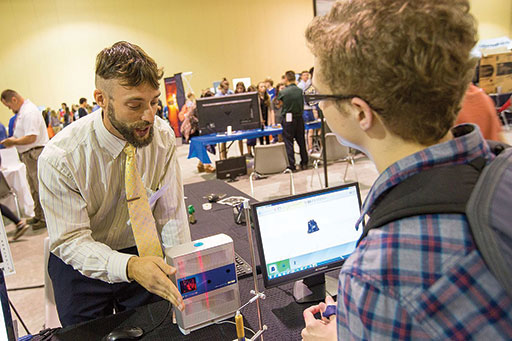
Since helicopter repair is so niche, is it more difficult to attract young talent to this profession? “There is no doubt that helicopters require a level of specialized training that is not often taught in traditional classrooms,” Noble said. “Things like hands-on rotor track and balancing are rarely taught in Airframe and Powerplant courses because availability of a real helicopter to train on is difficult to get into schools. HAI has tried to work with our members to bring that capability to schools, but those resources are difficult to come by.”
Emphasize an Attractive Occupation
Yes, there are real challenges to attracting young talent to work as a rotorcraft technician; the work is often physically demanding in bad weather, and requires long and odd hours with unreliable schedules. Being an AMT means having a stressful job with pressure to resolve technical issues quickly and accurately. But building awareness of the many advantages of being a rotorcraft technician is a positive way to attract talent.
At HAI, Noble explained, through implementing collaborative strategy opportunities and because margins are normally so close in the helicopter community, pride can be built in what helicopters do for our communities and nation. “[This is] key to recruiting and retaining qualified mechanics. Helicopters are different than airplanes. Helicopters provide the infrastructure necessary for citizens to enjoy a high quality of life. We erect power grids, fight fires, provide law enforcement, agricultural spraying, lift power and environmental units to the tops of tall buildings, perform logging operations, transport crews to and from offshore oil platforms, and carry our sickest citizens to appropriate medical facilities. There is an endless list of jobs that helicopters do, and for a pilot, mechanic, support team to take pride in the services they bring to our society is instrumental in filling required and very necessary positions.”
Hulshoff agreed that one way the industry can promote a helicopter AMT career is to emphasize that rotorcraft operation ensures safe passage of passengers daily in the offshore energy industry and helps save lives with search-and-rescue services. “The United States depends on the energy industry to run and being a part of that industry can be very rewarding. [Also,] many AMTs prefer helicopters because the work is more challenging and offers a rewarding career. Our locations are mostly in Louisiana in the United States and a lot of our mechanics love the region for what it offers compared to other areas of the country. We have a very modern fleet of aircraft and are the largest operator of the latest generation AW139, AW189 and S-92 aircraft. AMTs like to work on current generation aircraft instead of the older Bell and Airbus models in the offshore oil and gas industry. We have a good mix of helicopters from single engines, light, medium and heavy twins in the United States that can offer lots of variety to our AMTs and that can also be a very rewarding aspect of their job.”
Money matters, and being a rotorcraft technician pays well. According to the U.S. Bureau of Labor Statistics, the median salary in 2020 for aircraft and avionics equipment mechanics and technicians was $66,680 per year and $32.06 per hour — a major selling point. And the job outlook (projected percent change in employment) from 2020 to 2030 for this career path is 11%; the average growth rate for all occupations is 8%.
Berger believes to make a helicopter mechanic a more attractive profession, “not unique to helicopter mechanics, but all professions, is quality of life and standard of living must improve–and not only salaries and benefits, but geographic locations as well. Mechanics often have to work night shifts and in remote locations far from family and friends.This is a tremendous challenge to attract new recruits.”
Another selling point is that rotorcraft mechanics can easily relocate, since there are jobs available virtually everywhere. “It offers worldwide opportunities, and for someone who doesn’t mind traveling, there are plenty of companies which have daily operations around the globe,” Noble said. “The helicopter community is smaller than the airplane community, but the jobs and tasks to be completed by rotorcraft are plentiful and require continuous operations. Aircraft maintenance provides an overwhelming sense of accomplishment especially when coupled with a mission set that saves lives, fights fires, provides community security, or many of the other helicopter profiles. I am certified to fly just about anything — multiengine airplanes, single engine airplanes, and helicopters — but the certificate I am most proud to carry in my pocket is the FAA Certificate that says I am an aircraft mechanic.”
